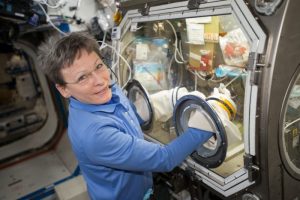Expedition 52 of the International Space Station
Expedition 51 astronauts Commander Peggy Whitson of NASA, Flight Engineers Oleg Novitskiy of the Russian space agency Roscosmos and Thomas Pesquet of ESA (European Space Agency) have been aboard the International Space Station since November 2016. On April 20, 2017, they were joined by NASA astronaut Jack Fischer and cosmonaut Fyodor Yurchikhin of Roscosmos.
Astronauts Thomas Pesquet and Oleg Novitskiy left to Earth on June 2 ending the Expedition 51 mission. Expedition 52 began at the moment the Expedition 51 crew members undocked from the ISS and began their journey home. They landed in Kazakhstan at 10:10 a.m.; 8:20 p.m. Kazakhstan time.
Living currently, at the International Space Station is Commander Fyodor Yurchikin, Flight Engineers Jack Fischer, and Peggy Whitson. On July 28 new crew members will arrive; cosmonaut Randy Bresnik, astronaut Paolo Nespoli from ESA, and cosmonaut Sergey Ryazanskiy.
The Mission Patch
NASA Johnson. ISS052-s-001 (01/27/2016) — Expedition 52 Official Patch
Theme: “Earth is our home”
Earth is surrounded by a house-shaped constellation thus depicting the patch’s theme. The Moon, closely touching the constellation, acknowledges the first steps taken there while Mars awaits not fat behind. The International Space Station is highlighted in yellow with the Roman numeral LII (52). Orbiting further away are the planets, Sturn and Jupiter which symbolize humanity’s exploration of deeper space. On the same orbit as the ISS a small Sputnik symbolizes the bridge from the launch of that first satellite to sixty years later with the launch of Expedition 52 on 2017.
Experiments
During Expedition 52, researchers will demonstrate more efficient solar arrays, study the physics of neutron stars, investigate a new drug to fight osteoporosis and study the adverse effects of prolonged exposure to microgravity on the heart.
Work started right away for Expedition 52 crew. On June 4, Jack Fischer and Peggy Whitson in control of the Canadarm2 released the ATK Cygnus for its deorbit back into Earth. Cygnus contained approximately 7,600 pounds of supplies and science experiments. On June 5, resupply vehicle SpaceX Dragon arrived at ISS. It was captured by Jack Fischer and Peggy Whitson using the Canadarm2 and docked to the Earth-facing port of the Harmony module. Dragon will remain attached until July 2 when it will be released for its deorbit and a parachute-assisted splashdown in the Pacific Ocean.
New science hardware delivered by Dragon cargo craft was installed by Jack Fischer. Two other experiments were extracted by ground controllers operating the Canadaarm2 and attached to the outside of the ISS.
Other experiments include:
- June 6: The Multiple User System for Earth, or MUSES, is an Earth-imaging platform that can help “improve navigation, agriculture and benefit emergency responders.”
- June 11: The Neutron Star Interior Composition Explorer, or NICER, “will research new insights into the physics of neutron stars and help scientists develop a pulsar-based, space navigation system.”
- June 15: Fischer monitored and took pictures of a six student-led biology experiment of mold and bacteria samples. Later, Fischer thawed protein crystal samples and observed them with a specialized microscope.
- June 17: The Roll-Out-Solar Array, or ROSA, will test a new advanced solar array. It “could power future NASA spaceships and communication satellites.”
- June 19: The Seedling Growth-3 Botany study research “how plant cells respond to lighting conditions in microgravity.”

Peggy Whitson Works on the OsteoOmics Bone Cell Study. Commander Peggy Whitson is working on the OsteoOmics bone cell study that utilizes the Microgravity Science Glovebox inside the U.S. Destiny laboratory
Ongoing experiments like the Rodent Research-5 study researches how to “improve the health of astronauts living in space and humans on Earth with bone diseases.” The “Cardiac Stem Cells experiment that seeks to understand the accelerated aging process that takes place in space.” On June 20, Whitson started packing synthetic DNA samples in a science freezer as well as the rodent research for its return to Earth next month aboard Dragon.
If you want to keep up to date with all things happening at the International Space Station follow NASA’s blogs.
Resources for Educators



